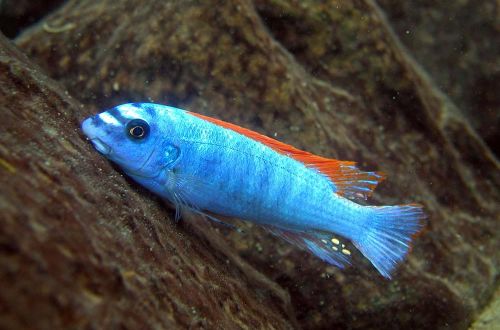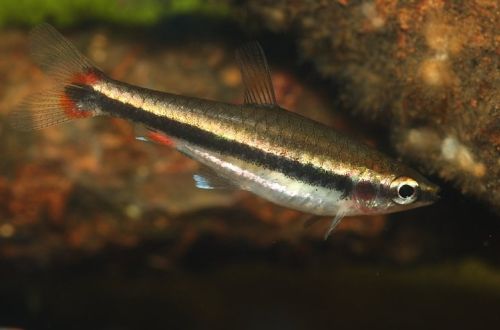
Zebra Mbuna
The Mbuna zebra or Pseudotropheus blue zebra, scientific name Maylandia zebra, belongs to the Cichlidae family. It used to belong to the genus Pseudotropheus, so the obsolete name is often used. A classic representative of cichlids, it combines a bright saturated color and a fighting disposition. It has a high degree of hostility towards other fish. It is recommended to keep in a species aquarium. Requires increased requirements for its care, so novice aquarists should refuse to buy this species.

Contents
Habitat
Wild representatives of the Zebra live exclusively in Lake Malawi in Africa. They live at various depths along rocky coasts, reefs, islands. They belong to the Mbuna group, which in translation from the local dialect means “inhabitants of the rocks.”
Requirements and conditions:
- The volume of the aquarium – from 200 liters.
- Temperature – 23-28°C
- Value pH — 7.2–8.8
- Water hardness – medium hardness and hard (10–25 dH)
- Substrate type – coarse sand and stones / boulders
- Lighting – moderate
- Water movement – moderate
- Size – 5–6 cm.
- Nutrition – vegetable with occasional meat supplements
Description
An elongated body with a slightly convex head and pointed ends of the dorsal and anal fins. The color is varied: blue, orange, black and white and bluish black. Color diversity is the result of both artificial selection and natural species. It is worth noting that it is often very difficult for a simple layman to determine this species outwardly, therefore, it is worth buying a Zebra only from professional aquarists and pet stores with a good reputation in order to avoid an accidental mistake. There are a lot of cases when, instead of one species, a completely different one is sold, this is due to the similarity of many cichlids from lakes Malawi and Tanganyika to each other.
Food
Accepts most dry foods. However, the optimal diet consists of plant matter. For example, you can serve seaweed flakes (usually spirulina), chopped nori – dried seaweed used in rolls is sold in many supermarkets. Periodically add high-protein foods – bloodworms, brine shrimp and similar feed. Do not overdo it, excess protein food leads to obesity and digestive problems.
Maintenance and care
Representatives of Lake Malawi require the same conditions of detention. The main condition is high quality and purity of water. It should be slightly alkaline, hard or medium hardness. Read more about the composition of water and ways to change its parameters in the section “Hydrochemical composition of water”. Update weekly by 10-15%, in case of poor filtration, increase the volume of water to be replaced up to 25%. The soil should also be cleaned at least once a week. The Zebra cichlid is very sensitive to pollution. The filtration system plays a key role in maintaining the biological balance of the aquarium. Choose the most efficient filter that suits your price. Other important equipment includes a heater, an aerator and a lighting system.
The design should be guided by the natural habitat. There are no plants in the aquarium, except for a few plastic decorative specimens. A significant part of the space should be occupied by piles, heaps of rocks / stones with numerous crevices and grottoes. coarse sand substrate.
Behavior
Extremely aggressive and quarrelsome fish in relation to other species. In addition, males are no less warlike towards each other. Keeping is possible in small groups – one male and 2-3 females, but on condition that the size of the tank is at least 200 liters and shelters are provided in the design, otherwise, in a small space, females will inevitably be attacked. You should make it a rule if you plan to keep several cichlids, then each male should have 200 liters of water.
Sexual differences
The male is larger than the females, has a brighter color and a pattern on the anal fin in the form of several colored spots. In addition, males develop a sort of hump/bump on their foreheads, which gets bigger with age.
Reproduction / breeding
With a harem content, the appearance of fry will not take long. During the breeding season, the color of the male becomes more intense to attract the opposite sex. He chooses a suitable place at the bottom – a free sandy space and makes several holes (spawning grounds). It is in these recesses that the female lays eggs and then immediately takes them with her mouth. The procedure is repeated in turn in several spawning grounds. As a result, the female’s mouth is filled with numerous eggs. Fertilization itself occurs in a very original way. The pattern on the anal fin of the male resembles eggs, the female mistakenly perceives this as a new portion of eggs and tries to swallow them. The male releases the seed and fertilization occurs. The female bears her offspring for 3-4 weeks before releasing the fry to swim freely. All this time, she cannot eat, so if she did not eat well before the breeding season, then the offspring are in danger of being eaten.
This breeding strategy is typical of most cichlids from Lake Malawi and ensures a high level of offspring survival in a very competitive environment.
Diseases
Under favorable conditions of detention and a balanced diet, health problems do not arise. The main causes of disease are poor water quality and poor diet. When keeping several males together (which is not recommended!) physical injuries are common, and as a result, various fungal and bacterial secondary infections. For more information on symptoms and treatment methods, see the Aquarium Fish Diseases section.
Features
- Hostility towards other species
- Harem content – 1 male and several females





